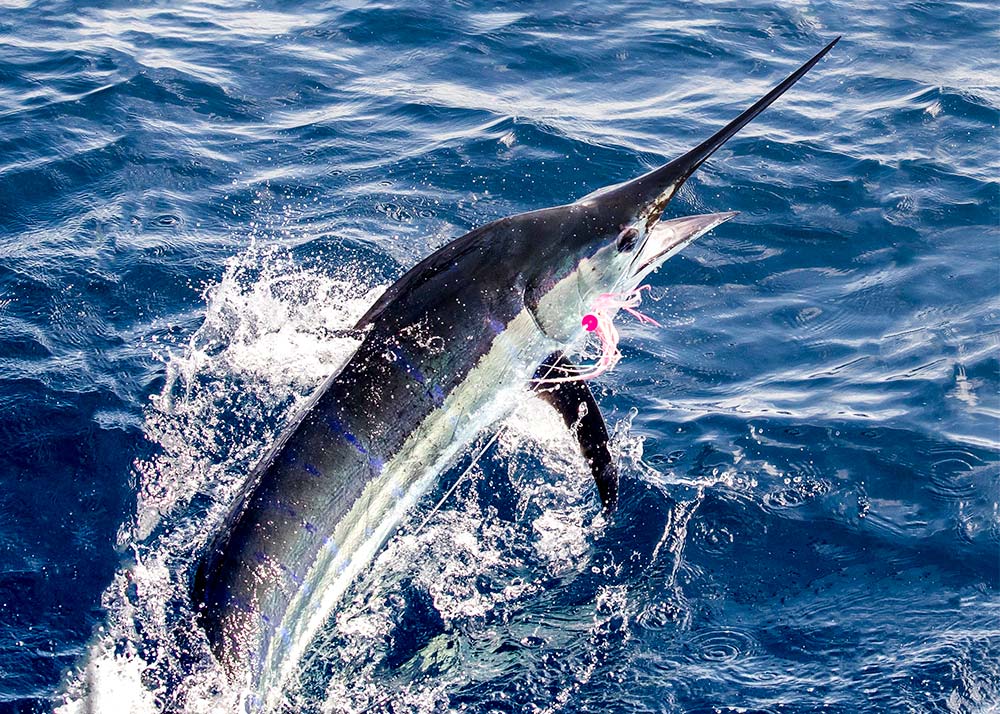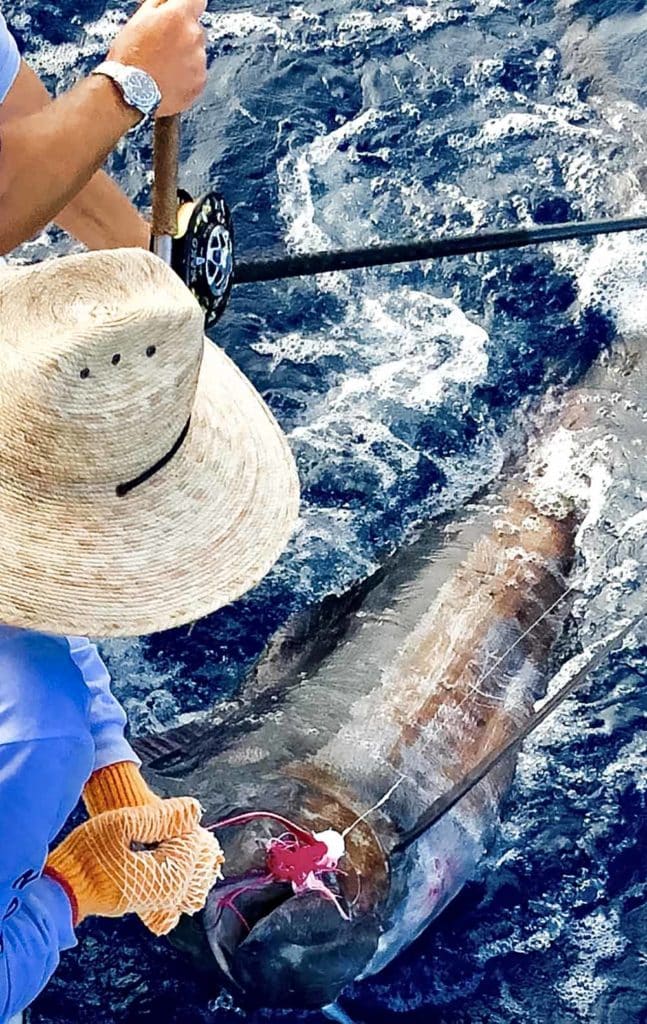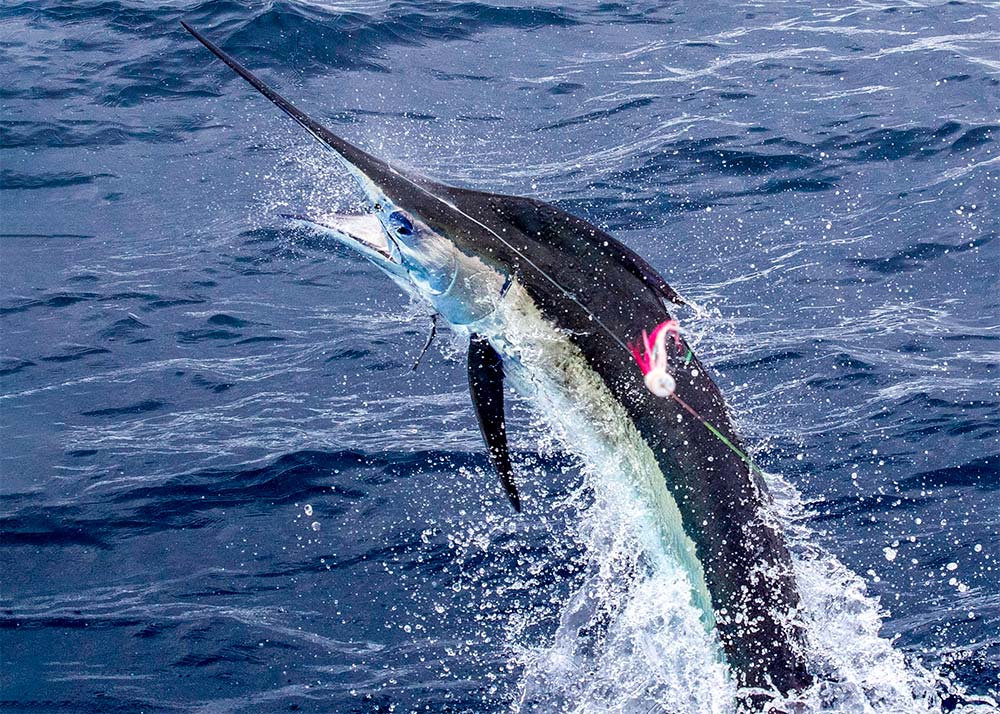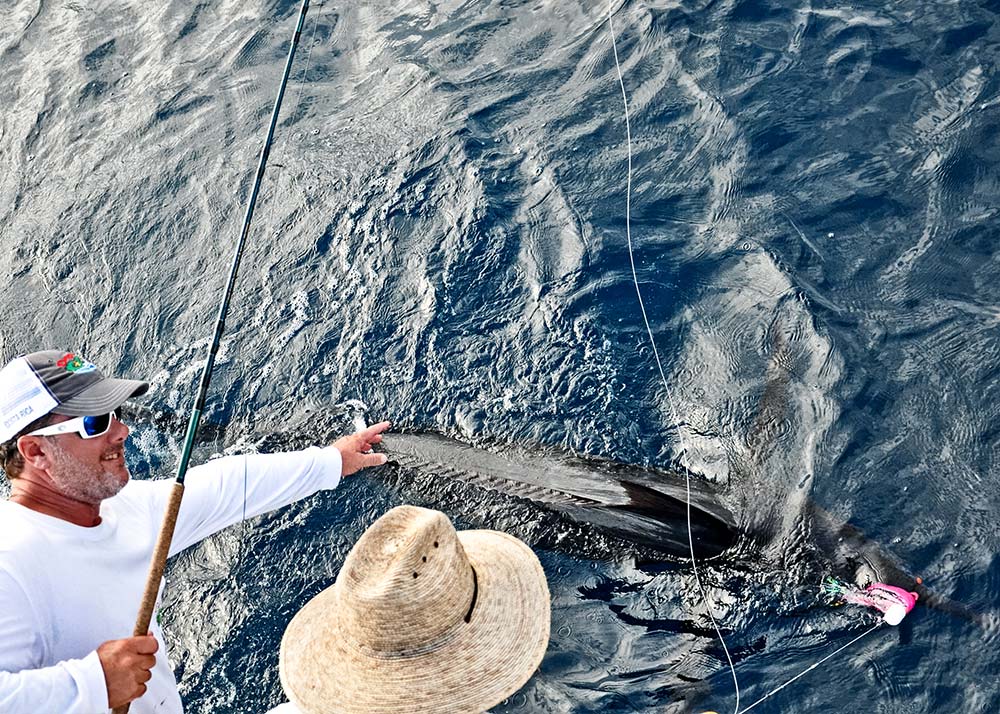
A blue marlin is a major challenge on conventional tackle. On a fly rod, it can be the catch of a lifetime. After all, hooking, fighting and landing a fish endowed with a three-foot bill and 200 pounds or more of muscle out in the deep blue is quite an undertaking.
With help from captains Rom Hamlin and James Smith, and renowned fly rodders Billy Pate, Nick Smith and Cam Sigler, all well versed in the billfishing game, Capt. Jake Jordan, himself a seasoned charter captain and globetrotting angler, has fine-tuned the gear and tactics required to succeed, and he shares them with aspiring big-game fly fishers, shortening their learning curve considerably while recording numerous releases along the way.

Training Grounds
Choosing the right location is paramount for getting sufficient reps to perfect marlin fishing with a fly rod. According to Jordan, the seamounts offshore of Los Sueños, Costa Rica, known for the amazing number of marlin they produce, are excellent hunting grounds, and that’s precisely where he, aboard the local sportfisher Dragin Fly, holds his marlin fly-fishing schools.
Over the past five years, Jordan and his fly-fishing disciples have landed 213 blue marlin over 136 days of fishing, all on 16- or 20-pound tippet, following the strict IGFA guidelines, which only allow a 12-inch length of heavy mono or fluorocarbon between the fly and the class tippet to prevent chaffing from the marlin’s rasp-like bill.
Luck certainly plays a part. For starters, you need the right bite for the fragile class tippet to survive the initial attack and impending hook-set intact. After that, keeping a blue marlin connected has more to do with the leader system and fighting techniques that Jordan and friends have developed.

Tuned Tackle
Jordan’s favored fly rod for marlin is Temple Fork Outfitters’ Bluewater HD, TFO’s 15-weight rod equivalent, which excels at casting the heavy line required to deliver a large, bushy fly that will entice a marlin and, during the latter portion of the battle, lift or pump the fish toward the boat. At all other times, however, the rod should be pointed directly at the line going in the water.
Rio’s Leviathan Billfish Shooting Head, a 31-foot, 550-grain, sinking fly line with a 50-pound-test core, not only will cast a billfish fly with ease, it’s also heavy enough to pull down and effectively chug the big, floating popper head of the fly. In addition, Jordan believes this heavy shooting head actually helps wear down a marlin and keep it on the surface.
Jordan joins the shooting head to 80 feet of Suffix High-Vis 50-pound mono, which serves as the running line, via a loop-to-loop connection, and attaches the mono to the 500 yards of 65-pound gelspun backing on his reel with another loop-to-loop connection. The mono running line is critical, acting as a shock absorber that will stretch as much as 10 feet before breaking. It’s that stretch, along with the right drag setting on a quality reel that will prevent a marlin’s violent head shakes and fast runs from parting the class tippet.
Jordan exclusively uses Mako reels, which he believes have the smoothest, most consistent drag system, especially when applying one pound of pressure, his preferred strike setting and the minimum to prevent a backlash at the moment during the strike when a marlin’s impressive horsepower kicks in.

Leader Configuration
The leader should start with a 9-foot butt section of 60-pound mono attached to the end of the shooting head via a loop-to-loop connection Once this connection makes it into the rod tip, you have joined the short list of anglers who have caught a blue marlin on the fly under IGFA rules.
Next comes the class tippet (usually 16- or 20-pound hard mono), at least 15 inches long, with Bimini twists on both ends to create double line, thereby doubling the strength for the ensuing connections. Make a loop knot on one of the Bimini twists to connect to the butt section, and use a Huffnagle knot to attached the double line from the other Bimini to a 100-pound shock tippet. This shock tippet can be made of mono or fluorocarbon, but no longer than 12 inches (including all knots between the eye of the hook and the class tippet), if you choose to adhere to IGFA rules. Otherwise, it can be longer.

Fly Selection
When a blue marlin comes in hot, it will eat just about anything it finds in its path, but a hot pink fly is easier for fish, angler and crew to spot. Typically, a large Cam Sigler popper head and tube fly combination does the trick, but Jordan will sometimes use a larger foam popper head in rough conditions.
On advice from Capt. Chris Sheeder, who has tallied thousands of billfish releases, Jordan has gone from a tandem hook rig to a single 8/0 or 9/0 Gamakatsu Octopus hook, increasing his hookup ratio, as well as making it easier on the fish and the mate during release.

Teaser Spread
Jake Jordan defers to the boat captain when it comes to choosing the teasers, which typically includes three Soft Head-style trolling lures, or two and a daisy chain of squids or birds, all without hooks. A trolling lure is deployed off a flat line from each transom corner, and the daisy chain from one of the outriggers — the left one if the fly angler is a right-handed caster, otherwise the right. Dredges are not recommended, as they are difficult to remove quickly from the water to eliminate the potential distraction for any marlin you raise.
The crew of the Dragin Fly likes to drag Laceration Lures off both flat lines, rigged with dorado bellies to let marlin get a quick taste and get them excited while continuing to tease the fish within casting range, greatly increasing chances for an aggressive take.

Bait and Switch
Fly fishing for marlin is a team sport, for it’s essential to have a person tending to each teaser, and let the angler concentrate solely on delivering the fly to the right spot at the right instant, then setting the hook and clearing the line before settling in for the fight.
It’s imperative to get the marlin to key on one of the teasers, and get the rest out of the water fast. The captain can handle one of the teasers in a pinch, but at least two mates or fellow anglers are needed to either tease a fish, should a marlin come up behind the lure they are managing, or to retrieve and get it out of the way, if the fish opts for another.
When a fish is raised, the fly should be tossed in the water and allowd to drag some 15 to 20 feet behind the boat. The teaser — with the marlin in hot pursuit — must then be retrieved within casting range. As soon as the fish is in comfortable range, the engines should be placed out of gear. Momentum will keep the boat moving forward, but soon the white water behind it will disapear, and that’s when the angler should take advantage of the water’s drag to load the rod and make a single backcast, then thrust the rod forward and shoot the fly.
Ideally, the fly should slap down beyond the fish, just as the teaser is yanked out of the water. If the timing is right, the marlin will turn, locate the fly, and rush the offering for a ferocious going-away bite. Despite the light drag setting (remember to set the drag for one-pound of pressure), the speed of the strike, coupled with sharp hooks, should result in an instant hookup.

Battle Technique
Immediately after the hook-set, allow the line to scream off the reel. Gain line at every opportunity, but do it by pointing the rod and turning the reel handle as fast as you can. Pumping the rod with the fish more than 100 feet away only wears out the angler.
Occasionally after the hookup, a marlin will stay in place, shaking its head in an attempt to shed the hooks, allowing a quick crew to back down to within a few yards. But more often, the fish will go crazy, greyhounding on the surface. Rushing in for the release on a freshly hooked marlin can land angler and crew in a dangerous situation, with a large billfish jumping into the cockpit. So Jordan prefers to let the fish make its initial run and settle down.
The sheer drag of the heavy shooting head tends to keep the marlin on the surface, so if you manage to stay connected after the initial mayhem, you can usually crank all the backing taken as the boat backs down, and begin fighting the fish when you get back to the 80-foot section of mono. Once the marlin is within 100 feet, increase the drag pressure up to 3 pounds. And when the fly line is on the reel, dial it up to 6 pounds, which is a lot of heat.

Do all this right, and you’re likely to achieve most releases after only 15 or 20 minutes, backing down as needed to close the gap and keep the tiring marlin close.









